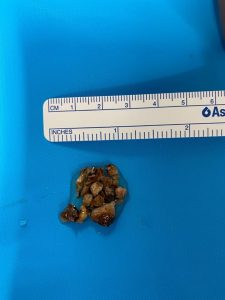Kidney stones are known for causing severe discomfort, so understanding kidney stone pain location may help you to identify a problem early on so that you can seek medical attention.
Kidney stones are known for causing severe discomfort, so understanding kidney stone pain location may help you to identify a problem early on so that you can seek medical attention.
Common Kidney Stone Pain Location: The Flank
The classic kidney stone pain location is often in the flank, which is the area on either side of your lower back, just below your rib cage.
Kidney stone pain in this location is caused by the ureter contracting in response to the presence of the stone(s). It is often described as “sharp” or “colicy”. It can come on quite suddenly, and usually goes in waves from 20-60 minutes of discomfort, before it stops and starts again.
Radiating Kidney Stone Pain Location
In addition to the flank, kidney stone pain location can radiate to other parts of the body. Many patients will report that their pain spreads to the lower abdomen and groin. In males, kidney stone pain can also be felt down to the testes.

Kidney Stone Pain Location and Urinary Symptoms
Kidney stone pain location is often also accompanied by urinary symptoms. Some patients may experience a frequent urge to urinate and/or pain with urination. There may also be changes in the colour of urine; it may appear pink, red, or brown, indicating the presence of blood.
Kidney Stone Pain Location: Kidneys vs Back Pain
Kidney stone pain location is sometimes confused with back pain. Distinguishing between the two is essential for your doctor to be able to make a proper diagnosis. While both conditions can cause pain and discomfort in the back area, kidney stone pain tends to be much more severe and persistent. Additionally, pain associated with kidney stone disease often shifts location and changes in intensity as the stone moves through the urinary tract, unlike typical back pain.
Kidney Stone Pain Location and Intensity
The severity of discomfort in the kidney stone pain location can vary depending on the size, position, and number of stones in the urinary tract. Even small stones can cause intense pain requiring urgent medical attention, if they obstruct the flow of urine.
Understanding Kidney Stone Pain Location and Managing It
Being aware of kidney stone pain location is the first step in managing kidney stone disease. Hydration is the most important factor in preventing kidney stones and their associated pain; having dilute enough urine can help to prevent any type of kidney stones and may help smaller stones to pass on their own.
In mild cases, over-the-counter pain medications may provide temporary relief, however persistent or severe pain should always be evaluated by your GP or urologist.
Kidney Stone Pain Treatment Options
The treatments that are offered by your urologist will be dependent on the size, number and location of kidney stones within your urinary tract. Your general health, lifestyle, and medical history will also be considered.
In milder cases, or where stones are very small and appear to be passing through the tract, certain medications may be prescribed to help manage pain and assist stone passage.
In cases of severe kidney stone pain, procedures like extracorporeal shock wave lithotripsy (ESWL) can be used to break down larger stones, while ureteroscopy with laser allows for the fragmentation and removal of stones using a small, specialised scope and basket.
Preventing Kidney Stone Pain and Recurrences
Once you have had a kidney stone, the risk of recurrence is up to 10% per year. Taking preventative measures is important in reducing recurrence. This includes staying hydrated and reducing sodium intake. In some instances, maintaining a diet low in oxalates may also help, however you should not go making drastic changes to your diet without your urologist’s advice. Having regular check-ups with your doctor may also help you monitor and manage your risk factors for kidney stone disease.
Kidney Stone Pain Location: When to Call a Doctor
Any time you are experiencing pain, you should seek medical attention. If you have any of the following symptoms, you should seek emergency medical care:
- Pain that is severe, that comes on suddenly
- +/- Difficulty or urgency to urinate
- +/- Blood in your urine
- +/- Fever/chills
- +/- Vomiting
Kidney Stone Pain Location: The Bottom Line
Understanding kidney stone pain location is really important for early identification and effective management of painful stone disease. By recognising the specific areas where kidney stone pain often occurs, you can seek medical advice and treatment in a timely manner. If you experience any pain or urinary symptoms consistent with kidney stone disease, you should contact your GP or urologist for an accurate diagnosis and appropriate care plan.
